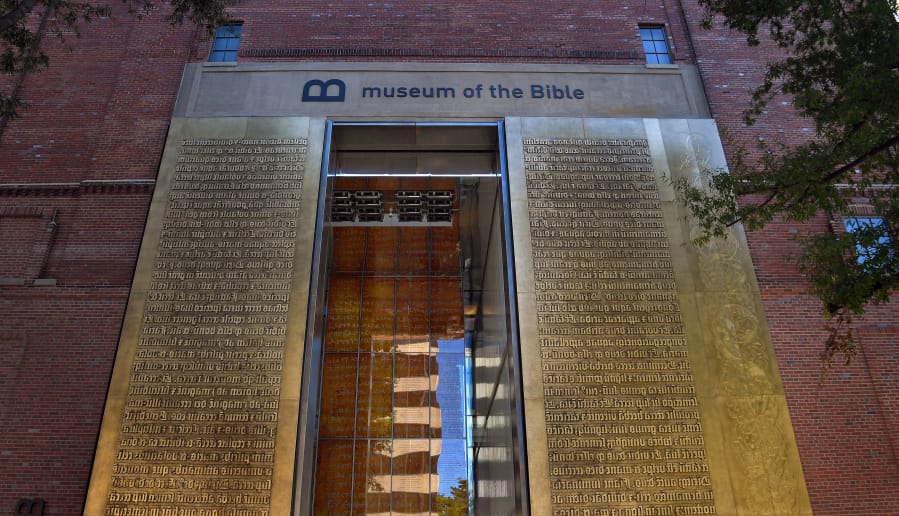WASHINGTON — The Museum of the Bible — a prominent new institution off the Mall in Washington, D.C. — announced Monday that it has removed five prized items once thought to be historical Dead Sea Scrolls after concluding that the fragments may not be authentic.
The pieces were examined by the Germany-based firm BAM, which tested them and concluded that they might not truly be parts of the ancient manuscripts found in the Qumran Caves of Israel’s West Bank.
“If questions arise, then we want to answer those questions in an objective and honest way,” Jeffrey Kloha, the museum’s chief curatorial officer, told The Post. In an earlier statement, Kloha called the process an opportunity for the museum to show its “commitment to transparency.”
The $500 million museum faced skeptics before it opened because it was chaired and funded largely by the conservative Christian family that owns Hobby Lobby, the mega-chain at the center of a divisive Supreme Court case about how far religious liberty rights go. Founders said the museum was meant to be a scholarly, inclusive look at the Bible, yet its founding board was almost entirely evangelical. It has drawn visitors of all faiths since it opened.
The museum, just south of the Mall, sent the five fragments to BAM for analysis in April 2017 after previous studies raised questions about its fragments. Kipp Davis of Trinity Western University has been doing research on the fragments, which is funded by the museum. He told its officials that at least seven of the fragments probably were “modern forgeries,” according to a statement by the museum.
The five fragments now believed to have “characteristics inconsistent with ancient origin” have been displayed at the Museum of the Bible since it opened in November. Labels on the exhibit since it opened have warned guests that some scholars were skeptical of the fragments’ authenticity, the museum said in its statement.
Three other fragments have replaced the five that might not be real, and the museum said it plans to conduct more research about their authenticity. The museum has 16 fragments, including the five just removed.
Insight into text
The Dead Sea Scrolls are the oldest version of the Hebrew Bible and offer insight into what the sacred text looked like at the turn of the era, said Joel Baden, a professor of the Hebrew Bible at Yale Divinity School, and a critic of the museum. The scrolls were created between the early 1st century B.C. and 70 A.D. Most were written in Hebrew, while a few were written in Aramaic and Greek.
“What they reveal is the biblical canon wasn’t fixed, that there were multiple editions of biblical books floating around simultaneously and that there was this great discrepancy among Jewish communities about which laws to follow,” Baden said.
A collector purchased the inauthentic fragments beginning in 2009 and donated them to the museum over the following years, Kloha said. He declined to say how much money the collector paid for the fragments, but Baden said fragments can sell for half a million dollars to $1 million apiece.
Kloha said museum curators thought the fragments were likely to be real when they received the donations, which had not yet been studied by academics. The museum quickly gave researchers access to the fragments to compare handwriting styles and the layout of the writing, Kloha said.
Curators typically seek to authenticate materials by analyzing the archaeological excavations that uncovered them, but Kloha said this type of analysis was frequently impossible for the Dead Sea Scrolls fragments. Researchers could not necessarily link individual fragments with the specific caves where they were found.
Kloha said although no single test can determine fragments’ authenticity, the museum decided to remove the five fragments based on the lack of information of their excavation, the academic analysis on them and the newly concluded scientific analysis.
“We don’t believe that it would be accurate to present these as authentic fragments at this point,” he said.
Most fragments of the Dead Sea Scrolls are thumbnail-sized, charred scraps of parchment that are nearly illegible, Baden said. Their small size makes it difficult to determine their authenticity, and no test can definitively determine that a fragment is real.
Academics study the texts’ script, handwriting, grammar and language, as well as whether it fits with the cultural context it theoretically came from, Baden said.
He said biblical artifacts are commonly faked, and the Dead Sea Scrolls are particularly popular among forgers. Most forgeries don’t end up on display because museums typically evaluate their authenticity before making them available, Baden said.
Baden said the Museum of the Bible was “deeply irresponsible” to display the five inauthentic fragments before it put them through the full round of evaluations. He said curators should not have replaced the fragments with three others they have yet to fully research.
Kloha said the three fragments now on display don’t have the kinds of “telltale signs” of inauthenticity included in the five fragments that were removed.



